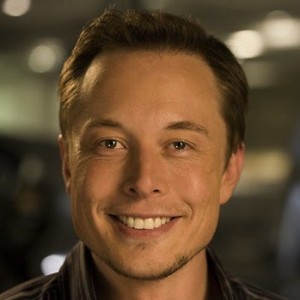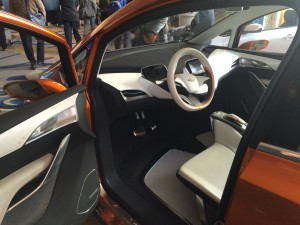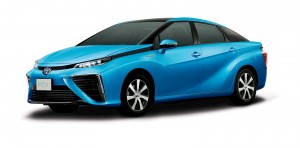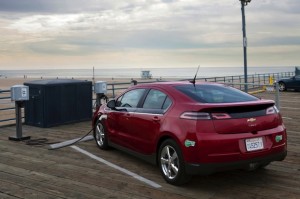 Though the future of electric vehicles remains murky at the federal level, due to Donald Trump’s hostility to climate science and love of oil and gas, the industry will receive a big boost from two companies this holiday season: California electric utilities and Volkswagen.
Though the future of electric vehicles remains murky at the federal level, due to Donald Trump’s hostility to climate science and love of oil and gas, the industry will receive a big boost from two companies this holiday season: California electric utilities and Volkswagen.
Volkswagen has agreed to a partial settlement from its emissions-cheating scandal, which could bring huge dividends to California if it’s enforced properly:
To mitigate environmental harm from their actions, the companies must pay $225 million into a national mitigation fund. California will receive about $41 million of that money for mitigation programs in the state designed to address the additional NOx emissions released by the vehicles in question. This is in addition to $1.2 billion VW is already paying California for mitigation and zero-emission vehicle (ZEV) infrastructure as part of the 2-liter partial consent decree.
The settlement, together with a previous consent decree, also requires the company to fund two “Green Cities” in California, which must have populations of at least 500,000 with many living primarily in disadvantaged communities. These cities will receive “concentrated investment in ZEV programs like car sharing, ZEV transit or freight services and infrastructure and public awareness efforts to support those programs.”
An additional $25 million dollars will support programs such as “replace-and-upgrade programs for high-emitting cars in disadvantaged communities (EFMP Plus-up) and the Clean Vehicle Rebate Project (CVRP), which provide rebates and financial assistance for purchase of ZEVs.”
But perhaps most significantly, California consumers can expect new models of EVs to be fast-tracked:
[T]he manufacturers will provide at least three new models of electric vehicles for sale in California — including at least one SUV model — before 2019. The companies must add a second electric SUV model by 2020 and keep these electric models on the market through at least 2025. ZEV credits generated by placement of these vehicles in California cannot be sold on the ZEV credit market.
All in all, these provisions will definitely provide a major shot in the arm for the industry. As E&E news reports [paywall]:
Analysts say that in the early years of the investment, Volkswagen could nearly double the money spent on construction of EV charging infrastructure, seen as a way to spark more sales. States, cities and private companies are scrambling to get a piece of the Volkswagen pie.
“It’s just so much money,” said Ashley Horvat, vice president of strategic initiatives at PlugShare, an EV charging firm. “It will lay the groundwork for the future, and everybody is waiting to see how they fit into that future.”
Of course, some of the existing charging industry companies are afraid this investment will crowd out competition, while others worry it will allow Volkswagen to gain a monopoly advantage in a new industry — hardly a punitive outcome given the company’s malfeasance.
They also worry it may overshadow recently approved electric utility investment in charging infrastructure. California regulators are finally letting these utilities get into the charging game, as E&E reports:
Last Friday, the California Public Utilities Commission approved a plan by the Pacific Gas and Electric Co. to build 7,500 EV charging stations in its Northern California territory. Ratepayers will shoulder the $130 million cost. It is the third major Californian utility to have an EV charging plan approved, after Southern California Edison and San Diego Gas & Electric.
All in all, states and private companies are (no pun intended) charging ahead with electric vehicles. This momentum may be necessary come January, when the new administration and its oil-and-gas allies in Congress could create some major headwinds for this vital industry.
Anti-clean technology forces, emboldened by Trump’s electoral college win, are eager to kill federal support for electric vehicles and solar power. Critical to the effort is a smear campaign directed at Tesla CEO Elon Musk, especially now that the company has merged with SolarCity. As EcoWatch uncovered:
Elon Musk is being targeted by the conservative political action committee, Citizens for the Republic. The group’s so-called Sunlight Project is behind an incendiary lobbying campaign and website called, “Stop Elon Musk from Failing Again,” with a mission of divesting the Tesla/SpaceX/SolarCity boss from federal clean energy subsidies.
The group cites a misleading Los Angeles Times article stating that Tesla is set to receive $4.9 billion in government subsidies. As Musk described, the figure is derived from “adding up everything that’s ever happened and including things that will take the next 20 years” and doesn’t compare with subsidies for fossil fuels.
It’s not clear who’s funding the effort, but right-wing ideologues are definitely spearheading it:
The Drive‘s Liane Yvkoff also reported that Citizens for the Republic’s board members Craig Shirley and Diane Banister are partners of the right-wing public relations firm Shirley and Banister Public Affairs, that has represented the National Rifle Association, commentator Ann Coulter and the Tea Party Patriots. Posts on “Stop Elon Musk From Failing” are authored by someone called “stopelon,” the same user name on Alt Left Watch, which also happens to be managed by the PR company.
But is it too late to stop the momentum for clean technologies like EVs? As the Detroit Free Press reports, EV sales in places like California have been accelerating due to state policies, while global investment in EVs continues:
These are global companies, and China and Europe are moving forward with their incentives for non-gas-burning vehicles. Whatever the Trump administration does, the rest of the world won’t abandon the Paris Agreement to reduce the global growth of carbon emissions.
“The industry has made a massive investment in electric vehicles,” [Dan Sperling, founding director of the University of California Davis Institute for Transportation Studies] said. “While some would prefer to slow it down, most companies are going to continue along that path.”
And Bloomberg as well notes the global investment in alternatives to gas-powered vehicles:
Gasoline has been the world’s choice to power automobiles. From the 1950s onward, when Henry Ford’s dream that every middle-class American could own a car became reality, gas stations sprung up next to drive-through restaurants and strip malls and transformed the landscape of America and economies across the globe.
Now, however, car companies — most obviously Tesla, but also incumbents such as General Motors Co., BMW AG and Nissan Motor Co. — are putting their money, and reputations, behind electric vehicles. With technology improving — especially for batteries — prices are falling. Tax breaks, particularly in China, are helping sales.
Meanwhile, as Salon writes, other automakers are following Tesla’s playbook of investing in batteries as building energy storage and not just vehicle transport.
So it may be too late to stop the momentum behind battery price declines and improved options for EVs. But this smear campaign is an attempt to turn Musk into the bogeyman of clean tech and rally the right to ditch the federal tax credits. Advocates should counter by debunking the claims and trumpeting the domestic economic and job benefits of these technologies.
I’m a big believer that islands will lead the way in decarbonizing the economy. Many of them have ample renewables resources, such as geothermal on Hawaii’s Big Island and Iceland, wind and hydro on Kodiak Island, and solar energy on other Hawaiian islands.
Now, on the heels of the big Tesla-SolarCity merger, the American Samoa island of Ta’u used the companies’ products to go 100% renewable. As the Washington Post reported, the island’s leaders wanted to stop depending on expensive, imported diesel fuel to generate electricity:
“[They] basically just put out a solicitation to see if anybody could provide an alternative to diesel, and that’s something that we responded to,” said Peter Rive, co-founder and chief technology officer of solar provider SolarCity, which was recently acquired by Tesla.
The result is a system composed of more than 5,000 SolarCity solar panels and 60 Tesla Powerpack battery storage systems. The new microgrid could save the island nearly 110,000 gallons of diesel fuel each year, which amounts to about 2.5 million pounds of carbon dioxide emissions, according to data from the U.S. Energy Information Administration.
The microgrid is already up and operating, according to Rive, and covering about 99 percent of the island’s power needs. The battery system can provide three full days of power to the island without sun, he added. And it can fully recharge in seven hours of sunlight.
It may have been easier for this island to go 100% renewable compared to other places, given its ample sunshine and small population. I’m assuming the island lacks energy-intensive industries as well. But the lessons can be applicable to other islands and economies, particularly when you factor in other generation technologies, like wind and hydropower.
Now if Ta’u just switches to all battery-electric vehicles, they’ll pull off the full eco-paradise.
The Chevy Bolt is a big deal. It’s the first sub-$30k (with incentives) electric vehicle that has an over-200 mile range. 238 mile rated range, to be precise, which seems to be holding up in real-world conditions. It’s set to hit the showrooms in January, and it should open up EVs to a much broader market of consumers.
In a very good sign, Motor Trend has already named it the 2017 Car of the Year:
Perhaps the most impressive thing about the Bolt EV is there are no caveats, no “for an electric car” qualifiers needed in any discussion. It is, simply, a world-class small car, and that’s before you factor in the benefits inherent in the smoothness, silence, and instant-on torque provided by the electric motor. The ride is firm and sporty, but transmitted road noise is very well damped. The steering has slightly artificial weighting, but brake feel is natural, and once you learn to use the higher regenerative braking modes, you can pretty much drive all the time without touching the friction brakes at all.
But some question the lack of sleek “coolness” that distinguishes Tesla from all the boxy or buggy EV competitors. In an otherwise positive review, Lawrence Ulrich at The Drive laments the aesthetics:
I truly hope I’m wrong here. But the Bolt, like so many would-be Detroit pioneers before it, fails to absorb the blackboard lesson of that hot professor Tesla: A cutting-edge car should be cool. It should spark daytime reveries and nighttime desire.
The Bolt’s cool factor, frankly, hovers right around zero. Electric tech aside, there’s no sense of gotta-have, from the kitchen-appliance exterior to a cheapskate cabin that screams “Middle America” like Jim Harbaugh’s WalMart khakis.
Personally, I think the car doesn’t look that bad, and it’s certainly an improvement over models like the Volt, i3 and LEAF. But I do wonder why automakers aren’t marketing the cars more as performance machines rather than Eco-vehicles. Tesla has exploited that aspect of EVs perfectly, leaving competitors in the dust. I’m no engineer, but I wonder if Chevy could have smoothed out the blocky shape a bit to give the car an edge.
In the end, my guess is the Bolt will be a success, especially with the Model 3 coming next. I wholeheartedly agree with Ulrich that it will make similarly priced short-range EVs like the LEAF obsolete. Ultimately, the car signifies that EVs are here to stay and accessible to a much larger group of buyers. I look forward to seeing them on the road.
The race for zero emission vehicles has largely been between hydrogen fuel cell technology and batteries. Many analysts feel there really isn’t a competition, given the superiority of batteries for both environmental and economic impacts. A new study from Stanford underscores this reality:
The results were definitive.
“In terms of overall costs, we found that battery electric vehicles are better than fuel cell vehicles for reducing emissions,” Felgenhauer said. “The analysis showed that to be cost competitive, fuel cell vehicles would have to be priced much lower than battery vehicles. However, fuel cell vehicles are likely to be significantly more expensive than battery vehicles for the foreseeable future. Another supposed benefit of hydrogen – storing surplus solar energy – didn’t pan out in our analysis either. We found that in 2035, only a small amount of solar hydrogen storage would be used for heating and lighting buildings.”
Perhaps more significantly, Toyota — one of the few automakers that has gone all-in on hydrogen — appears to be retrenching in favor of batteries, according to Elektrek:
Now one of the most prominent proponents of hydrogen fuel cell cars, Toyota, is reportedly planning to mass produce battery-powered long-range electric cars by 2020.
The news comes as Toyota is having difficulties selling the Mirai, its hydrogen cars, in the US. Despite cutting the price on several occasions, with now a lease at only $350 (down from $500) in California, the Japanese automaker can’t find a market for the vehicle and only delivered 782 units since it started deliveries last year – and that’s including the state buying dozens of them for their own fleets to justify the millions of dollars spent on refuelling infrastructure.
And as Nikkei reports:
Eyeing a full-scale entry into the electric vehicle market, the Japanese automaker will create an in-house team for planning and development as soon as the new year. Toyota will seek cooperation from group companies to start production quickly.
Toyota aims to develop an EV that can run more than 300km on a single charge. The platform for models such as the Prius hybrid or Corolla sedan is being considered for use in building an electric sport utility vehicle.
This is definitely significant news, particularly given that it seems to be in response to stagnant fuel cell vehicle sales. Of course, we shouldn’t pit technologies like these against each other, as hydrogen could potentially have a role for zero-emission transportation like long-haul trucking that is less suited for batteries. But it’s also not great to spend a lot of public dollars on hydrogen fueling infrastructure that won’t be needed. Maybe this latest development signals a new future for investments in EVs, without the distraction of fuel cells.
It’s official: Tesla shareholders approved a merger with SolarCity. Despite financial analysts’ concerns, the basic concept makes sense: electric vehicle drivers will want solar panels to make fueling the vehicle at home cheaper. Solar customers will be interested in electric vehicles because they already have cheap fuel at home. So there are big marketing/customer acquisition benefits.
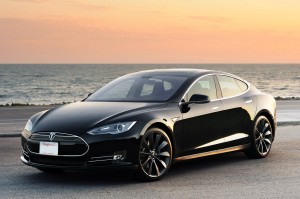 But more importantly, as rooftop solar sales decline and state regulators pull back on incentives, batteries will be crucial to keep solar competitive. Why? Right now most rooftop solar customers use the grid as their battery. I have panels on my home, for example, and when I have surplus electricity in the summer, I export to the grid and get a retail credit for that surplus. I then apply that retail credit to my grid usage in the dark winter months, and “true up” after a full year accounting.
But more importantly, as rooftop solar sales decline and state regulators pull back on incentives, batteries will be crucial to keep solar competitive. Why? Right now most rooftop solar customers use the grid as their battery. I have panels on my home, for example, and when I have surplus electricity in the summer, I export to the grid and get a retail credit for that surplus. I then apply that retail credit to my grid usage in the dark winter months, and “true up” after a full year accounting.
But regulators are doing away with that bargain already in places like Hawaii and Nevada. Soon new solar customers are going to need an actual battery to store their surplus solar. It would be the same model that I have, but you no longer need the grid to store your electricity, and you don’t need regulators requiring utilities to do so. Instead, with a big enough battery, you capture and use all your solar energy on site.
The one question I have is whether the economics are still good enough to encourage people to purchase both a battery and solar array. I doubt a typical Tesla home battery will be big enough to capture all the surplus energy in the summer months, meaning some power will be lost that the grid would otherwise have used. But as battery and solar prices decrease and electricity rates increase, the deal could be good enough.
Either way, the merger represents a sea change in our electricity system, packaging transportation and home energy use in a way we’ve never seen. If all goes well for the company, Tesla could one day become a monopoly like we’ve never seen, with a gas station, utility, and car company all rolled into one.
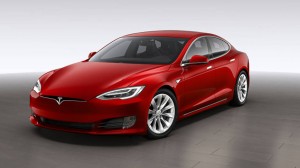 Yesterday I asked if Trump could stop the clean technology momentum. Part of that discussion relates to electric vehicles, and Rani Molla and Liam Denning in Bloomberg make the optimistic case that Trump can’t stop the transition to EVs:
Yesterday I asked if Trump could stop the clean technology momentum. Part of that discussion relates to electric vehicles, and Rani Molla and Liam Denning in Bloomberg make the optimistic case that Trump can’t stop the transition to EVs:
Even if U.S. federal regulations loosen, the country accounts for only a fifth of global vehicle sales. And other regions, especially in fast-growing Asian markets such as China and India, have reasons of their own to demand more efficient vehicles, ranging from heavily polluted cities to national security (why embrace ever-increasing dependence on foreign oil?). Don’t forget, also, that roughly one of every eight new U.S. vehicle registrations is in California, which is allowed under the Clean Air Act to set more stringent fuel-efficiency targets than the feds.
But maybe we shouldn’t be so optimistic that Congress won’t interfere with California’s emissions policies. As E&E News reports [paywall]:
Then there’s the issue of the state’s Clean Air Act waiver. California has an EPA-granted waiver under the federal Clean Air Act, which allows the state to set its own rules for vehicle emissions. Eleven other states follow that policy. Many automakers comply with California’s rule, rather than build cars for just a few states.
Each time it’s renewed, EPA gets to take another look, said Kathryn Phillips, director of Sierra Club California.
“I actually worry that they’re going to go into the Clean Air Act and take out the aspect of it that has allowed California to act independently on tailpipe emissions,” Phillips said. “That’s the place where we’ve had some of the greatest impact on air pollution, not just in this state but around the world, because California has the ability to call for tighter emissions controls from auto manufacturers.”
As with the future of renewables, we’re in a wait-and-see mode. And it’s true that global commitment to electric vehicles is only getting stronger. But at this point, at least here in the United States, no environmental policy is secure.
A common concern about the “greenness” of electric vehicles is that the batteries have a negative environmental footprint, from manufacturing to disposal. True, batteries have an environmental cost, but it is minimal over the lifecycle of the vehicles compared to the alternative of a petroleum-fueled vehicle (of course, the true alternative of walking, biking or transit is the ideal, if not always practical for most people).
But there is also a huge environmental upside to the battery: the prospect of hundreds of thousands of used, cheap batteries available to bottle surplus renewable energy for later use. As David Roberts on Vox.com described:
In four or five years, the batteries in the roughly one and a quarter million EVs currently on the road are going to start to wane. EV owners will either replace them, or replace the cars entirely.
That means we’ll have a lot of used batteries on our hands — batteries with plenty of life left in them, but which are no longer suitable for EVs. What to do?
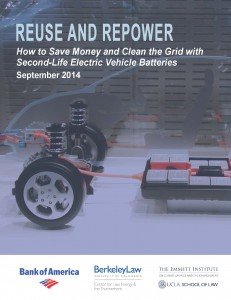 It’s worth reading the article in full for an overview. Or you can see our UC Berkeley/UCLA Law report on the subject back in 2014, Reuse and Repower: How to Save Money and Clean the Grid with Second-Life Electric Vehicle Batteries.
It’s worth reading the article in full for an overview. Or you can see our UC Berkeley/UCLA Law report on the subject back in 2014, Reuse and Repower: How to Save Money and Clean the Grid with Second-Life Electric Vehicle Batteries.
A lot has happened since that report came out, particularly with pilot projects. For example, as the MIT Technology Review reported, BMW combined batteries from 100 cars for a grid-scale energy storage facility in Hamburg, Germany, which is capable of storing 2.8 megawatt-hours of energy and delivering up to two megawatts of power. It’s designed to meet periods of peak demand to avoid having to ramp up fossil-fueled power plants. And a French web hosting company in Normany is deploying used Nissan EV batteries to capture surplus renewables to lower energy costs. These are just a few of the growing number of pilot projects happening around the world.
And studies on the subject are increasingly bullish. Fortune covered a new report this past summer from Bloomberg New Energy Finance, which predicts that roughly a third of electric car batteries are expected be reused by 2025, totaling 29 gigawatt hours of used batteries. 10 gigawatt hours of those could be repackaged for grid needs.
But the challenges are myriad. Greentech Media has a great article describing the barriers and options going forward, many of which we discussed in our 2014 report:
“Batteries are a lot like people: They each have their own individual state of health depending upon what they’ve been exposed to and how they’ve been treated over the course of their life,” said Ken Boyce, who’s developing a safety standard for second life batteries at Underwriters Laboratories, a major safety certification firm.
But despite the potential and progress being made, one major automaker is notably absent in these efforts: Tesla. As the Bloomberg New Energy Finance report author Claire Curry observed in Greenwire [paywalled]:
Tesla, however, is not one of the players, partly because it is more interested in recycling batteries at its Gigafactory in Nevada, Curry said.
“Tesla has so much stationary storage capacity it needs to sell,” she said.
I asked Elon Musk about his interest in used EV batteries in early 2014 at a public event, and he said he was absolutely in favor. His staff later approached me to walk back his comments a bit. It seems that they want to make money selling new batteries and don’t want the competition from cheap used ones.
But Tesla may be swimming against the tide, as a surge in used EV batteries could change the energy storage market and clean the grid for the better — starting in just a few short years.
In the wake of the VW emissions-cheating scandal, the proposed settlement involves allowing VW to invest heavily in electric vehicle infrastructure, per E&E News [paywall]:
Under the settlement, Volkswagen AG will have to invest $2 billion over 10 years to increase access to EVs by supporting charging infrastructure and public outreach, with $800 million allotted to California. ChargePoint Inc. and California lawmakers including U.S. Rep. Anna Eshoo (D) and state Senate President Pro Tem Kevin de León (D) argued that the special fund lacks oversight and risks stifling the EV-charging industry.
California has some experience with these kinds of settlements, and it’s not good. As I’ve written before, the state settled with NRG’s parent electricity company for defrauding California ratepayers during the phony electricity crisis and rolling blackouts at the turn of this century.
As “punishment,” NRG got to spend $100 million on a new line of business: EV charging infrastructure. The settlement terms though have never been followed, and the California Public Utilities Commission took over a year just to hire an auditor to find out what’s going wrong. The audit hasn’t even begun yet, a year-and-a-half later.
So if regulators and the court go down this path with VW, let’s hope they put real teeth into monitoring and enforcement of the settlement terms. Otherwise this deal won’t end up so well for taxpayers and the defrauded.
In Fortune, former Tesla VP Cristiano Carlutti dishes on the company and the upcoming Model 3 (Tesla’s first mass-market EV, due in 2017):
As far as the downsides of the Tesla Model 3, let’s try to look at things from a different perspective: the biggest downside of Model 3 in my opinion is that it doesn’t exist yet. Lots of things can change until the launch date and I would assume that, when it was presented earlier this year, Model 3 was probably nowhere near a decent stage of development.
In order to understand this perspective, you have to take a different look at the way the company operates: in my opinion, it’s fundamentally a very focused marketing machine that until now has been focused on selling shares, with car sales instrumental to that. Before some fans attack me because of this comment, let me tell you that… it was the right thing to do!
In other words, Elon perfectly knew since the beginning that he would need a massive amount of money to become a car OEM and that, in order to raise that money, he had to create and sustain excitement in investors even more than in clients. Another way to look at it is that at this prices, the purchase of Tesla stock is more irrational than the purchase of a Model S: the latter is a very good car, competitive in its market, while the stock is more of a bet (or a gamble) on future dividends that nobody knows if they will ever appear. Car sales and car fans are just instrumental to raise the money Tesla needs to reach the point where it will be self-sustainable: the gamble is that financial markets keep drinking the company’s kool-aid at least until the company becomes self-sustainable. If they stop drinking it too soon, it will be game over and an historical failure, if believers sustain the company long enough, it will be a masterpiece of entrepreneurship and a tremendous success.
A lot is at stake with the future of Tesla. The company is, in my view, the most important private sector clean technology purveyor out there. Elon Musk has almost single-handedly pushed EVs to the forefront of the public imagination, spurring other automakers to follow suit. He also is betting big on energy storage and its marriage with solar PV, which will be essential to decarbonizing the grid. Combined with electric transportation, Tesla’s technology deployment promises to help the world decarbonize at a much greater rate than we otherwise would.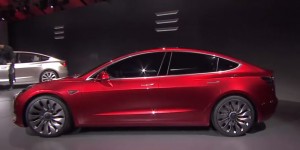
I don’t want to overstate it, but Tesla is making a strong claim to being in position to quite literally save the world (at least from out-of-control climate change).
So we need the company to succeed and raise the capital it needs for the deployment it envisions. If Carlutti is to be believed, let’s hope Musk can keep stoking the imagination of investors — and more importantly, that he and his team can deliver on their big promise with the Model 3. They’ll need a car that meets expectations at the right price and delivery time, without some of the quality issues plaguing the Model S.
It’s possible to do, but not certain. Reason for us all to be nervously optimistic.

